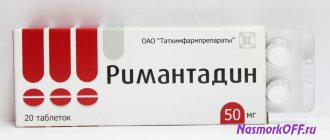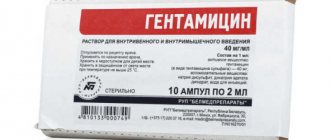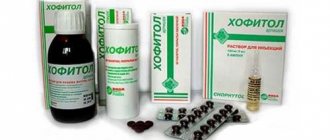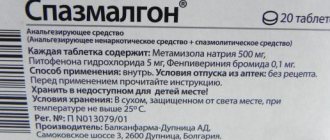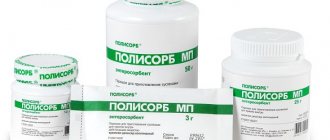The main principle of gout therapy is constant control of uric acid levels by suppressing its production and increasing the rate of elimination from the patient’s body. This allows you to stop acute attacks of pathology, prevent their occurrence, and prevent the deposition of urate in the kidney and joint structures. Allopurinol is a drug that reduces the concentration of uric acid and its salts in any liquid medium of the human body. The drug actively inhibits their production, preventing the occurrence of painful symptoms of gout.
But Allopurinol has a wide list of contraindications, and if used incorrectly, the likelihood of its systemic side effects significantly increases. Consulting a doctor will help minimize the risk of developing dyspeptic and neurological disorders. The rheumatologist will determine the dosage regimen taking into account the severity of the pathology, the degree of joint damage, and the number of complications that have developed.
special instructions
The drug should be taken with caution in case of impaired liver or kidney function, or hypothyroidism.
At the beginning of the course of therapy, systematic monitoring of liver function is necessary. During treatment with the drug, monitoring of diuresis is necessary; the amount of fluid consumed should be at least 2 liters. At the beginning of the course, an exacerbation of the disease is possible; non-steroidal anti-inflammatory drugs or colchicine are prescribed to prevent the condition. With adequate therapy, urates may dissolve in the renal pelvis and fall out into the ureter. Hyperuricemia without additional symptoms does not require discontinuation of the drug. For tumor diseases, it is recommended to use Allopurinol before starting treatment with cytostatics, choosing the minimum effective dose. To reduce the risk of xanthine deposition in the urinary tract, it is recommended to take measures to maintain diuresis and alkalinization of urine. Simultaneous use with cytostatics requires monitoring of the peripheral blood picture. During treatment you should not drink alcohol. Patients whose activities require high concentration and rapid psychomotor reactions should take the drug with caution.
Allopurinol and alcohol
Drinking alcohol during treatment with Allopurinol is not allowed, since the risk of side effects and aggravation of clinical symptoms significantly increases. This applies to drinks of any strength, and even one dose drunk (a glass of vodka or a glass of beer) can lead to undesirable consequences.
Allopurinol and alcohol are absolutely incompatible, since ethanol provokes the formation of uric acid in tissues and slows down its excretion by the kidneys. This will almost inevitably cause urate deposition and increased symptoms.
Important: in order not to harm your health and get the maximum effect, you should refrain from drinking for the entire period of treatment.
Effect on the ability to drive vehicles and operate machinery Allopurinol may reduce the ability to concentrate and the speed of psychomotor reactions.
Indications for use
Allopurinol is used to help patients diagnosed with hyperuricemia that cannot be corrected by diet. The drug is also used for the following indications:
- urate urolithiasis;
- urate nephropathy;
- removal of uric acid;
- treatment of primary or secondary hyperuricemia of various origins;
- congenital enzyme deficiency;
- urolithiasis disease;
- consequences of kidney stones (in the form of stone formation);
- radiation, cytostatic therapy, as well as treatment with corticosteroids;
- prevention of hyperuricemia.
Features of therapeutic use for gout
When using Allopurinol for gout, the clinician expects a certain therapeutic effect. In the case of this pathology, it is necessary to reduce the amount of newly formed uric acid, which provokes an exacerbation. Basic therapy is intended to reduce the number of such exacerbations of the disease. Then gout is well controlled, although it requires constant adherence to a specific diet.
In assessing the effectiveness of the drug "Allopurinol", doctors' reviews are the most revealing. Clinical effects and cases of combined drug-induced organ damage are subject to characterization. Due to the fact that the drug affects the course of biochemical reactions, the side effects of its use should theoretically be significantly greater than those of receptor-dependent drugs. However, Allopurinol has a small number of clinically important side effects, and its therapeutic value is quite high.
How to use
The daily portion is determined individually in connection with the degree of uric acid concentration. To reduce the risk of minor reactions, therapy should be started with 100 mg once daily and the dose should be increased only if uric acid concentrations do not decrease sufficiently.
The instructions for use for Allopurinol (300 mg) indicate the following course:
- for mild conditions – from 0.1 g to 0.2 g per day;
- for moderately serious conditions – from 0.3 g to 0.6 g per day;
- for serious conditions - from 0.7 g to 0.9 g per day.
If the daily dose exceeds 300 mg, it must be divided into several doses (no more than 300 mg at a time).
When calculating the dose of a substance per patient’s body weight, use doses of 2-10 mg/kg.
Children and teenagers. The daily serving is 0.01 g/kg body weight, divided into three doses. The largest daily portion is 0.4 mg. Take 0.1 g tablets.
Mature age. Due to the lack of specific information regarding the use of the drug in this category of patients, it is recommended to use the lowest therapeutically justified doses
It is necessary to take into account the likelihood of pathology of renal function in elderly patients
Kidney pathologies. Since the drug and its metabolites are excreted by the kidneys, if their function is pathological, an overdose is likely if the portion is not selected properly.
In case of severe pathology of kidney function, the maximum daily dose is 0.1 g. It is acceptable to use a single dose of 0.1 g at intervals of more than days (every couple of days).
Patients with liver pathology.
Patients with liver pathology should be prescribed the lowest doses. At the beginning of treatment, it is recommended to periodically monitor the characteristics of liver function tests.
Tablets of 0.3 g do not need to be prescribed to these patients due to the high content of the functioning element.
The tablets should be taken after meals, without chewing, with plenty of water.
The duration of treatment depends on the course of the disease. In order to prevent the creation of oxalate and urate stones and for primary hyperuricemia and gout, long-term therapy should be used in most cases. For secondary hyperuricemia, a short-term course is recommended depending on the increase in uric acid levels.
"Milurit"
"Milurit" is a fairly popular foreign substitute for the original medicine, but it is quite difficult to find in pharmacies.
Analogues for the treatment of gout: “Sanfipurol”, “Allozyme”, “Remid”, “Allopin”, “Purinol”, “Allopurinol Nycomed”, “Apo-Allopurinol”, “Allopurinol-Teva”, “Allupol”, “Allopurinol-Egis” "
The cost of the drugs depends on the number of tablets in the package and the dosage, but on average it ranges from 65 to 150 rubles. One of the most purchased and frequently prescribed dosages is 100 mg. But for patients with a progressive disease or its severe form, purchasing the drug is unprofitable, since its dosage is too small, and to obtain the required amount of active substance (600-900 mg), you will need to immediately drink 6-9 tablets, and this is extremely inconvenient. Therefore, for patients requiring a higher dosage, drugs in an amount of 300 mg are recommended. However, while a 100 mg package contains 50 tablets, a 300 mg package contains only 30 tablets.
Let's name a few more analogues of Allopurinol.
The list of substitutes includes the well-known drug Allopurinol-Egis, produced in Hungary by the pharmaceutical company Egis. This manufacturer is considered a leader in the production of drugs for the treatment of gout.
A popular manufacturer of generic drugs is the pharmaceutical industry, which produces medicines that are no different in composition from the original ones.
Another world-famous manufacturer of generic drugs is , which produces cheap analogues of original drugs.
Special instructions for the use of the drug Allopurinol
It should be taken into account that on the 3rd–4th day after stopping Allopurinol, the indicators of uricosuria and uricemia return to the original, increased level
Treatment should be long-term; an interval of more than 2-3 days between doses of the drug is undesirable. The drug should be used with caution in cases of mild renal failure (adults in a dose of no more than 0.2 g/day). During the use of Allopurinol, diuresis in adult patients should be maintained at a level of at least 2 l/day
It is necessary to ensure a neutral or slightly alkaline urine reaction to prevent the formation of stones. For this purpose, drugs that alkalize urine are used simultaneously with Allopurinol. To prevent possible attacks of gouty arthritis at the beginning of treatment, you can prescribe NSAIDs or colchicine (adults, 0.5 mg 3 times a day). At the beginning of treatment with Allopurinol, a systematic study of the functional state of the kidneys should be carried out.
"Hello"
One of the most popular and well-known analogues is “Allo”, which has the same active ingredient as “Allopurinol”, and therefore can rightfully be considered a complete substitute. Dosage depends on the condition of the patient. For example, if the symptoms are mild, 200-300 mg per day should be taken orally, and if the symptoms are pronounced, then 400-600 mg per day. Tablets are taken 2 times a day after or during meals, for example, immediately after breakfast. Other data, including side effects, contraindications and indications, fully correspond to the original drug.
What other analogues of the drug “Allopurinol” exist?
Side effects
- Lesions of the skin and their derivatives: baldness, furunculosis, hair bleaching;
- Metabolic processes: increased concentration of fats in the blood;
- Urinary system: the appearance of edema, the appearance of blood in the blood, inflammation of the kidneys, increased concentration of uric acid in the blood;
- Central and peripheral nervous system: increased fatigue, dizziness, drowsiness, coma, involuntary contractions of skeletal muscles, multiple lesions of nervous tissue, weakness, headaches, impaired motor activity, depressive syndrome, paresis of muscles of various localizations, convulsive syndrome;
- Sense organs: cataracts, impaired taste perception, impaired visual perception, changes in the optic papilla;
- Cardiovascular system: decreased heart rate, increased blood pressure;
- Hypersensitivity reactions to Allopurinol: various allergic skin lesions, multiple lesions of the lymph nodes, increased body temperature, febrile states, Lyell's syndrome, joint pain, increased number of eosinophils, Stevens-Johnson syndrome;
- Endocrine system: diabetes mellitus;
- Reproductive system: infertility, enlarged mammary glands, sexual impotence;
- Hematopoietic system: increased number of agranulocytes, decreased number of leukocytes, decreased number of platelets, anemia;
- Digestive system: liver inflammation, vomiting, stool disorders, nausea, increased activity of liver enzymes, inflammation of the oral cavity, liver dysfunction, drooling.
Contraindications
| Allopurinol is contraindicated for use | The medication is prescribed with caution, choosing the optimal dosage |
| In case of hypersensitivity to components | Along with ACE inhibitors (medicines to lower blood pressure) and diuretics |
| In severe forms of renal or liver failure | Patients with hematopoietic disorders (the process of formation and maturation of blood cells in the body) |
| During pregnancy and lactation | Patients with chronic kidney and liver diseases |
| For hemochromatosis (hereditary disorder of iron metabolism) | For patients with diabetes |
Excessive iron deposition in the liver in hemochromatosis
Allopurinol is not recommended for use:
- if excess uric acid can be normalized through diet;
- with an exacerbation of gout (at the beginning, the medication can provoke an attack of the disease, which is associated with the removal of uric acid from existing deposits).
Indications for use
Prescribed for diseases that are accompanied by hyperuricemia, including primary or secondary gout, kidney stones, in which urate is formed.
Effective in the treatment of primary and secondary hyperuricomia in the following diseases and conditions:
- different types of hematoblastomas - lymphosarcoma, chronic myeloid leukemia, acute leukemia;
- radiation and cytostatic therapy of tumors, in particular in children;
- psoriasis;
- pathologies associated with enzyme disorders (Lesch-Nyhan syndrome);
- extensive traumatic injuries;
- massive GCS therapy;
- renal failure;
- violation of purine metabolism in childhood;
- formation of mixed oxalate-calcium kidney stones.
Use for concomitant diseases and conditions
The available expert reviews of the drug “Allopurinol” indicatively characterize its use in diseases associated with gout. Theoretically, only kidney and liver diseases require stopping the use of the drug or reducing its dosage. If an allergy to additional components or the active substance of the drug is detected, desensitization or refusal to use Allopurinol is required.
During pregnancy and breastfeeding, the use of the drug is contraindicated. In case of renal failure of various origins, complete discontinuation is not required. The drug can be prescribed in doses depending on the glomerular filtration rate. When creatinine clearance is less than 20 ml/min, only 200 mg of the drug per day is allowed. For GFR less than 10 ml/min, only 100 mg of Allopurinol per day is used. If a patient with gout is on dialysis, then the use of 200-400 mg is allowed on the day on which the session was performed.
Pharmacokinetics
The drug is quickly absorbed in the upper parts of the esophagus. After internal use, the drug appears in the blood plasma after half an hour to an hour. The bioavailability of the substance is in the range of 67-90%.
Peak saturation is reached after an hour and a half. The drug practically does not combine with proteins found in plasma. The amount of its discrepancy is within the figure of 1.3 l/kg.
The drug rapidly (plasma half-life two hours) oxidizes through xanthine oxidase and aldehyde oxidase to oxypurinol, which is also considered a strong xanthine oxidase inhibitor, but the half-life of the metabolite can last from thirteen to thirty hours. Given the long half-life, gradual accumulation may occur early in the cure until steady state is achieved. In patients with good kidney function, the average concentration is five to ten mg/l after consuming a dose. Allopurinol is excreted mainly by the kidneys, with less than 10% of the substance excreted in unmodified form. Approximately 20% is excreted in the feces. The active substance is excreted in the urine in an unmodified form after tubular reabsorption.
Instructions for the use of Allopurinol tablets (EGIS, Teva, Nycomed, etc.), reviews of which are positive, state that pathologies of the kidneys lead to an increase in the half-life of oxypurinol, for this reason patients with renal failure should Follow the advice regarding dosage.
Price and analogues
Analogues and substitutes of the drug can be purchased in pharmacies for free sale without a doctor’s prescription
The cost of Allopurinol tablets ranges from 70-150 rubles. Therapy based on this drug takes a long time. If a patient has chronic gout, he will have to take the medicine for the rest of his life.
Not all patients are suitable for treatment with Allopurinol. In this case, it is advisable to use its substitutes. Analogs of the drug have a similar effect. These include Zilorik, Vulflex, Allupol and Purinol.
Pharmacological properties
Treatment of gout with Allopurinol is effective due to the fact that the drug belongs to the group of drugs that can inhibit the production of urate and uric acid itself. The principle of action of the drug is associated with the process of inhibition of the enzyme xanthine oxidase, which is actively involved in the biosynthesis of urates.
Constant use of Allopurinol for gout helps reduce the level of uric acid salts in the blood. The medication takes a long time to dissolve most of the formed urates, which are present in the kidneys, on articular cartilage and in soft tissues. This reduces the size of tophi in the joint area. The intensity of arthralgia also decreases and the frequency of exacerbations of the pathological process decreases.
pharmachologic effect
In case of gout at the initial stage of its course, it is usually enough to exclude foods high in purines from the diet to prevent relapses. But in severe forms of pathology this is not enough. Patients are prescribed Allopurinol, a structural isomer of hypoxanthine, a naturally occurring purine found in the body.
Hypoxanthine is oxidized to xanthine, from which uric acid is produced. A specific enzyme, xanthine oxidase, is responsible for this process. Allopurinol blocks it, breaking the chain of unwanted transformations of hypoxanthine.
Blocking the enzyme causes a decrease in the production of uric acid and a simultaneous increase in the concentration of hypoxanthine and xanthine. They are metabolized to the purine-related adenosine and guanosine monophosphates. These ribonucleotides provoke reversible inhibition of the enzyme (amidophosphoribosyltransferase), which catalyzes the first specific reaction in the synthesis of purine nucleotides. As a result, the level of uric acid and its salts decreases, and urate deposits in the body dissolve. A course of Allopurinol for gout prevents the formation of urate in the kidneys and soft tissues. Therefore, the drug is prescribed to patients not only to relieve attacks of gouty arthritis, but also to eliminate the symptoms of kidney disease.
Adverse reactions
The instructions for use of Allopurinol list the following side effects.
At the beginning of therapy, immediate attacks of gout may occur.
Manifestations of minor reactions are more common in the presence of renal and/or liver failure or when used in combination with ampicillin or amoxicillin.
Dermatology: Stevens-Johnson syndrome, toxic epidermal necrolysis; baldness, furunculosis, Quincke's edema, hair depigmentation. The most common dermatological reactions (approximately 4%) appear at any time during therapy and can be expressed as a rash. If these reactions occur, taking the drug must be stopped immediately. After the symptoms have subsided, the drug can be prescribed in low doses (for example, 50 mg per day). If necessary, this dose can be increased over time. In case of secondary manifestation of a dermatological rash, the use of the substance should be interrupted, as severe hypersensitivity phenomena may occur.
Immune system: delayed hypersensitivity reactions, accompanied by fever, dermatological rashes and other pathologies that negatively affect health (reversible increase in transaminases and alkaline phosphatase); cholangitis and xanthine stones; anaphylactic shock.
Liver: pathologies of liver function from asymptomatic increases in liver function tests to hepatitis (including liver death and granulomatous hepatitis).
Digestive tract: vomiting, nausea, diarrhea; hematemesis, steatorrhea, stomatitis.
Blood: severe pathologies of the bone marrow occur extremely rarely, especially in patients with renal failure; very rarely, changes in blood parameters, true erythrocyte aplasia, appear.
Nervous system: ataxia, peripheral disease, eating disorders, coma, migraine, neuropathy, stupor, dizziness, lethargy, numbness.
Cardiovascular system: bradycardia, arterial hypertension.
Pharmacological characteristics of the drug
"Allopurinol" belongs to the group of anti-gout drugs. The main active ingredients are allopurinol and its active metabolite oxypurinol. Their pharmacodynamic effects are caused by a violation of the synthesis of uric acid with the development of a urostatic effect. Ultimately, this leads to a decrease in its concentration with subsequent dissolution of urates.
Due to its good solubility, Allopurinol has high bioavailability. The drug is well absorbed in the lumen of the small intestine. In the stomach it does not enter the systemic circulation. Presence in the blood plasma is observed already half an hour after administration, and the maximum concentration is observed after 1.5 hours. Accordingly, the maximum concentration of allopurinol metabolite, oxypurinol, is observed three hours after oral administration.
The drug has a long half-life and is therefore capable of accumulation. In patients at the beginning of therapy, an increase in drug concentration is observed, which stabilizes after one to two weeks of therapy. Due to long-term elimination, Allopurinol (doctors' reviews confirm this) is not recommended for use by persons with renal failure. In patients with preserved renal excretory function, accumulation is not observed.
How to take Allopurinol for gout dosage, rules of administration
Before starting treatment, it is recommended to study the instructions for use of the medicine, contraindications, which are compared with the health status of each patient. If in doubt, you should consult your doctor.
The tablets are taken orally after a meal, without chewing and washed down with clean, still water. When undergoing a course of therapy, you need to drink enough water every day and adhere to a certain diet to increase the solubility of urates and maintain normal diuresis.
Adult patients and children after ten years of age need to take 100 or 300 milligrams of medication per day. At first, it is recommended to take one 100 mg tablet per day, then the dosage is gradually increased, increasing it by 100 mg of medication every week. As a result, in the third week you need to take the drug in an amount of 300 mg per day.
In severe cases, the doctor may prescribe 600 or 800 mg per day. In this case, the dosage is divided into 2, 3 or 4 doses at equal intervals. The maximum daily amount should not exceed 800 mg of the drug.
Children from 3 to 6 years old are prescribed the medicine in an amount of 5 mg per kilogram of body weight, children from 6 to 10 years old - 19 mg/kg. They need to take the pills three times a day. In this case, the maximum daily dosage should not be more than 400 milligrams.
Patients with impaired renal function are prescribed a medicine of 100 mg per day, when undergoing hemodialysis - 300 mg after each procedure 2 or 3 times a week.
Many people are interested in the question of how many days to take Allopurinol for gout. The minimum course of therapy is about four months. During this time, uric acid levels normalize. Gout attacks stop after 6-12 months from the start of therapy.
Your doctor will tell you how long to take Allopurinol for gout and in what dosage. The drug can be used for three years with short breaks.
The medication must be discontinued gradually. Otherwise, the disease may worsen.
How much to take Allopurinol for gout? Doctors say that it takes 6 to 12 months to eliminate an acute attack of the disease. It takes the same amount of time for existing deposits to dissolve and leave the body. After eliminating the signs of pathology, the drug continues to be taken in a minimum dosage as a prophylaxis. It is recommended to lead a healthy lifestyle and diet at this time.
Instructions for use
Treatment of gout with Allopurinol tablets should begin with minimal doses. Gradually, the dose is increased to the point that will be indicated by a specialist or instructions for use of the drug.
The medicine should be taken after meals. It is highly undesirable to chew the tablets. Wash them down with plain water. You should not change it for any drinks, as this will only increase the load on the gastrointestinal tract.
When treating with Allopurinol, it is necessary to follow a drinking regime and a therapeutic diet. These measures can improve the effectiveness of therapy.
The duration of the course depends on the severity of the disease and the effectiveness of the drug in each individual case.
The dosage of the drug for gout should be as follows:
- children who have reached the age of ten and adults can take 100-300 mg per day. This dose should be adhered to for 7-21 days. As maintenance therapy, you should drink 200-600 mg per day;
- Children aged 3-6 years are prescribed 5 mg of medication per kilogram of weight. Patients 6-10 years old are treated with an amount of the drug equal to 10 mg per kilogram of body weight. The pediatrician calculates exactly how much Allopurinol a child should drink.
The maximum daily dose of the drug should not exceed 800 mg per day.
Possible side effects
The drug is easily tolerated and usually has no side effects, however, in rare cases the following undesirable side effects may develop:
- Central nervous system: development of depressive states, headaches, neuropathy.
- Cardiovascular system: high blood pressure, likelihood of developing bradycardia, anemia, vasculitis, leukocytosis, leukopenia.
- Gastrointestinal tract: development of dyspeptic disorders (nausea, vomiting, abdominal pain, diarrhea); stomatitis.
- Genitourinary system: development of acute renal failure, formation of peripheral edema, weakening of potency.
- Development of allergic reactions. Allopurinol can provoke the formation of skin rash, itching, urticaria, erythema multiforme, toxic epidermal necrolysis, purpura, and bullous dermatitis. In rare cases, bronchospasm may develop.
If these symptoms are observed, you should stop using the drug and consult a doctor.
Generic allopurinol: reviews of clinical use
Allopurinol is a drug that is included in a number of drugs. The latter are produced by more than ten companies under their own trade names. More often, the state and commercial pharmacy chains present Russian and Ukrainian generics, which are produced by the Borshchagovsky Pharmaceutical Plant, OJSC Organika, OJSC Akrikhin, the Danish company Nicomed and the Hungarian EGIS.
Reviews from patients and doctors about generic versions of the drug Allopurinol are practically the same. The reason for this is the simple chemical structure of the drug and its simple synthesis. From the point of view of pharmacological production, this aspect is extremely important, because it makes it possible to minimize the amount of by-products of synthesis that have no therapeutic value. Therefore, the clinical effectiveness of all allopurinol drugs is approximately the same.
Recommendations
People with gout should use caution during the first two weeks of treatment with this drug. This is due to the likelihood of exacerbation of the pathology
Doctors often prescribe additional analgesics or colchicine during this period.
Before completing the course of treatment, it is recommended to monitor the concentration of uric acid in the body. To do this, a urine test is performed. If the medicine is used correctly, on the second day of therapy, tests will show changes in a positive direction. Tests are also needed in order not to provoke a drug overdose and to adjust the treatment regimen in a timely manner.
Description of the drug and features of its effect on the body
In a healthy body, uric acid is excreted through actively functioning kidneys and is not retained in the joints of the body. If this function is impaired, the substance will accumulate, causing the formation of stones and lingering in the joints, causing gouty deposits. Allopurinol helps prevent the synthesis of uric acid. It has analogues, for example, Colchicine or FullFlex, which have a similar effect and have a diuretic effect.
Once in the body, the Allopurinol tablet is absorbed in the esophagus, enters the stomach and begins to act approximately 1.5 hours after administration. A small part, about 20% of the drug is excreted through the intestines, but the larger and main part passes through the kidneys. The mechanism of action of the drug is to inhibit the production of uric acid and dissolve excess urates, preventing their deposition.
A week after the start of treatment, the doctor conducts a repeat study to check the dynamics of the disease. Most often, diagnostic results provide information for changing the prescribed treatment, adjusting the doses of medications taken, so that the body does not overdose. However, Allopurinol continues to be taken, since the problems that are solved with its help do not go away so quickly; a long-term effect on the body is required.
Indications for use of Allopurinol
In accordance with the instructions, Allopurinol is indicated for use in cases of impaired purine metabolism in the following conditions:
- Chronic gout;
- Nephrolithiasis with the formation of urate and mixed oxalate-calcium stones against the background of increased uric acid in the blood serum;
- Kidney failure;
- Lesch-Nychen syndrome (enzymatic disease).
For preventive purposes, Allopurinol is effective for:
- Treatment of malignant tumors (including hematological malignancies) with cytostatics and radiotherapy;
- Psoriasis;
- Active therapy with glucocorticosteroids;
Extensive injuries accompanied by massive tissue lysis.
The use of Allopurinol in pediatric practice is practiced for disorders of purine metabolism in children in the treatment of leukemia and fermentopathy. There is also information about its treatment of epilepsy as an addition to the main therapy. According to available reviews of Allopurinol from pediatric neurologists, its action is effective and justified under certain conditions.
When is Allopurinol prescribed?
Allopurinol is a drug for prevention and complex treatment. It is prescribed to patients suffering from:
- gout (metabolic disorder, uric acid);
- gouty arthritis (inflammation of the joints due to disorders of purine metabolism);
- hyperuricemia (increased amount of uric acid in body fluids);
- nephropathy and urolithiasis (kidney diseases caused by crystallization and loss of urates in the tissue);
- kidney damage after chemotherapy and radiation of oncological tumors;
- disorders of purine metabolism after therapeutic fasting.
The drug is also prescribed when uric acid levels cannot be normalized through diet.
Click on photo to enlarge
Dosage and regimen of Allopurinol
The dosage and duration of treatment with the drug are determined by the attending physician individually, depending on the indications.
The recommended average scheme is:
0.2-0.4 g of Allopurinol per day divided into 3-4 doses for 2-3 weeks, after which the dose is reduced to 0.1-0.2 g per day. Treatment lasts several months; skipping doses of the drug for more than 2 days in a row is unacceptable.
The maximum permissible daily dose is 0.8 g.
As a prophylactic agent, Allopurinol is prescribed in a dosage of 0.4 g per day, the duration is also determined individually.
Cost of the drug, analogues
Tablets are dispensed upon presentation of a doctor's prescription. You can purchase them at any pharmacy chain. The cost depends on the dosage and manufacturer.
Average price is:
- Allopurinol (Russia) 0.1 50 pcs. – 91 rub., 0.3 30 pcs. – 107 rub.;
- Allopurinol-EGIS (Hungary) 0.1 50 pcs. – 103 rub., 0.3 30 pcs. – 135 rub.
The expiration date is indicated on the packaging; for Allopurinol it is 3 years, for Allopurinol-EGIS it is 5 years. The tablets are stored in a closed bottle or sealed cell packaging in a dry place at room temperature, away from heat sources. To ensure the preservation of medicinal properties, it is necessary to ensure that the temperature in the storage area does not rise above 25-30 degrees.
Analogues are medicines made on the basis of the same active ingredient – Allopurinol. At the moment, such drugs cannot be found in pharmacies. Of the anti-gout medications on the market, you can purchase Adenuric 0.08 tablets (France, 28 pcs. - 2,700 rubles) based on febuxostat.
Each body reacts to Allopurinol in its own way, so medical supervision is very important throughout the course of treatment, especially for patients at risk.
Side effects
Taking Allopurinol may be accompanied by rare side effects, which are caused by insufficient liver and kidney function. Undesirable consequences are as follows:
- furunculosis;
- disorders of the lymphatic and circulatory systems (anemia, agranulocytosis, thrombocytopenia, leukocytosis, leukopenia, eosinophilia and aplasia);
- immune system: hypersensitivity (arthralgia, fever, peeling of the epidermis, lymphadenopathy);
- metabolic processes (hyperlipidemia, diabetes mellitus);
- depression;
- drowsiness, headache, paresthesia, neuropathy, loss of mobility;
- vision (macular changes, deterioration in vision quality);
- symptoms of angina pectoris;
- increased blood pressure;
- diarrhea, nausea;
- from the biliary tract and liver - hepatitis;
- rash, Stevenson-Johnson syndrome, epidermal necrolysis, loss of hair color;
- myalgia;
- hematuria, uremia, renal failure;
- erectile dysfunction, gynecomastia.
Alcohol compatibility
The drug has not been tested for compatibility with alcohol. However, given the huge number of contraindications and side effects, you should be very careful when using this medicine.
The joint use of alcohol with it should be completely excluded due to the high risk of developing serious consequences.
Reviews
Patient reviews of this pharmacological agent are divided. Those who have benefited from it report unpleasant side effects. However, there are also users who note the absolute ineffectiveness of the drug.
Interaction with other drugs
Allopurinol delays the withdrawal of probenecid. The effectiveness of the drug decreases when using substances that can remove uric acid.
The simultaneous use of Allopurinol and Captopril may increase the risk of dermatological reactions, especially in chronic kidney disease.
The effect of anticoagulants (coumarin) may increase; for this reason, more frequent monitoring of blood clotting is necessary, as well as a reduction in the dose of coumarin derivatives.
In case of pathology of renal function, especially when drugs are used together, the hypoglycemic effect of chlorpropamide may be prolonged, which requires a dose reduction.
In significant portions, the drug inhibits theophylline metabolism; for this reason, at the beginning of therapy with Allopurinol or when increasing its dose, the level of theophylline in plasma should be monitored.
When using products with cytostatics, changes in blood composition occur more often than with a single administration of active substances. For this reason, blood counts must be monitored at short intervals.
When the drug is used in combination with vidarabine, fifty percent of the final plasma concentration is prolonged; therefore, such a combination must be used with caution to avoid increasing the severity of secondary reactions. When using the drug, the concentration of cyclosporine in plasma may increase - an increase in the severity of secondary reactions to cyclosporine is acceptable.
The drug promotes the accumulation of iron in liver cells. The intake of iron-containing medications should be reduced.
"Allopurinol" can lead to an increase in the severity of secondary reactions of certain pharmaceutical agents, in particular, when used simultaneously with captopril, the risk of dermatological reactions may increase, especially with permanent renal failure.
Interaction with drugs and alcohol
If you take “Allopurinol” together with alcohol, the effect of the drug will be completely neutralized; it is also dangerous to drink alcohol during the first month of treatment
When treating Allopurinol, it is necessary to take into account its interaction with other drugs. This is especially true for drugs that affect the rate of metabolism in the body. Some of them may negatively affect the active metabolites of this medication and reduce the effectiveness of its therapeutic effect. This information contains reviews from doctors in which they speak about the properties of this drug.
In this regard, it is necessary to avoid interaction of the drug with the following drugs:
- Pyrazinamide;
- Sulfinpyrazone;
- Probenecid;
- Phenylbutazone;
- Ketazone.
The drug can negatively affect the functioning of the body's internal systems if it is combined with certain types of antibiotics, for example, penicillins.
With caution, the drug can be combined with hypoglycemic and blood thinning agents. In this case, Allopurinol may enhance the activity of drugs that interact with it.
It is strictly forbidden to combine medications with alcoholic beverages. Alcohol-containing products increase the level of uric acid in the blood. As a result, the joint disease only worsens.
If you take alcohol and Allopurinol at the same time, the patient will develop dizziness, apathy, vomiting, cramps and diarrhea. Bleeding from internal organs cannot be ruled out.
Compound
Widely available in pharmacy chains, the drug has a composition that depends on the content of the active substance. One tablet contains 100 mg of allopurinol, has a grayish-white to white color, and is flat in shape. Detailed composition:
- allopurinol – 0.1 g;
- lactose monohydrate – 50 mg;
- potato starch – 32 mg;
- povidone K25 – 6.5 mg;
- talc – 6 mg;
- magnesium stearate – 3 mg;
- sodium carboxymethyl starch – 2.5 mg.
Tablets with allopurinol in a volume of 300 mg are grayish-white to white in color, flat in shape, scored on one side and engraved “E352” on the other. In addition to the main substance, one tablet contains the following components:
- microcrystalline cellulose – 52 mg;
- sodium carboxymethyl starch – 20 mg;
- gelatin – 12 mg;
- colloidal silicon dioxide anhydrous – 3 mg;
- Magnesium stearate – 3 mg.
Composition and release form
The tablets are taken orally after meals, the daily dose of the medicine is calculated by the doctor, taking into account the severity of the disease and the concentration of uric acid in the blood
The medication is available in the form of tablets of 100 mg and 300 mg. The pills are distinguished by their grayish-white or white color and flat-cylindrical shape.
In addition to the active substance (allopurinol), the drug contains auxiliary components:
- povidone K25;
- magnesium stearate;
- potato starch;
- talc;
- lactose monohydrate.
On one side of each Allopurinol gout tablet is the inscription “E352”.
Allopurinol. Analogues
The drug "Allopurinol" has more than 14 analogues. This means that patients to whom a doctor has prescribed this drug have the right to choose. The main indications for taking all the drugs listed below include not only the treatment of gout, but also excessive accumulation of uric acid in the blood (hyperuricemia) of various origins.
Indications also include a combination of gout with urate nephropathy, renal failure, and nephrolithiasis. Another indication is increased urate formation due to the presence of enzyme disorders. In addition to therapy, this drug can also be used to prevent nephropathy during treatment of cancer, as well as complete therapeutic fasting.
Each form has its own side effects, which are not too many and their manifestations are quite rare, but you need to know about them. For example, the most common: increased fatigue, diarrhea, weakness, baldness, blood disorders. This is confirmed by the instructions for the drug "Allopurinol".
Allopurinol tablets
The pharmacological classification classifies the drug Allopurinol as a hypouricemic and anti-gout drug that affects the functions and functioning of the genitourinary system. The action of the drug is based on the work of the active substance allopurinol. It dissolves urate compounds in urine, preventing the formation of stones in tissues and kidneys.
Compound
The drug is available in the form of round, white tablets with a flat surface, chamfer and score. Their composition is indicated in the table:
| Concentration of allopurinol, mg per 1 piece. | 100 or 300 |
| Additional components | Microcrystalline cellulose, corn starch, magnesium stearate, lactose, hypromellose |
| Package | 10 pieces in a blister, 30 or 50 pieces in a cardboard box |
Pharmacodynamics and pharmacokinetics
Allopurinol is a drug that interferes with the synthesis of uric acid. This substance is a structural analogue of hypoxanthine and inhibits the enzyme xanthine oxidase, which is involved in the metabolism of hypoxanthine to xanthine and xanthine to uric acid. This results in a decrease in the concentration of uric acid and its salts in urine and other body fluids. At the same time, existing urate deposits are dissolved; they are not formed in tissues and kidneys. Taking Allopurinol increases the secretion of hypoxanthine and the excretion of xanthines in the urine.
Once inside, the tablets are 90% absorbed from the stomach. Metabolism occurs with the formation of alloxanthin. The active substance reaches its maximum concentration in the blood after 1.5 hours, alloxanthin - after 4.5 hours. The half-life of the drug is 1-2 hours, of metabolites - 15 hours. 20% of the dose is excreted by the intestines, the remaining 80% by the kidneys and urine.
Indications for use
The instructions for use indicate the following indications for which Allopurinol can be prescribed to patients:
- treatment and prevention of hyperuricemia;
- combination of hyperuricemia with nephrolithiasis, renal failure, urate nephropathy;
- recurrence of mixed oxalate-calcium kidney stones against the background of hyperuricosuria;
- increased formation of urates due to impaired enzyme function;
- prevention of gout, acute nephropathy during cytostatic and radiation therapy of tumors, leukemia, complete therapeutic fasting.
Articles on the topic
- Maxigan - instructions for use and dosage, side effects, contraindications and analogues
- Uronephron - instructions for use and reviews
- Ampicillin - instructions for use of the drug
Combination with other substances
Another factor that does not allow self-medication is the presence of pathological reactions when combined with certain medications. Allopurinol should not be taken simultaneously with Azathioprine, Methotrexate, Theophylline, or mercaptopurines, as the toxicity of the latter increases. The medicine can also enhance the anticoagulant properties of indirect anticoagulants and the hypoglycemic effect of Chlorpropamide. Combination with Amoxicillin and Ampicillin can cause skin rashes. Before prescribing, you should find out what medications the patient is taking, and only then begin treatment.
Therapeutic effect
Is it possible to take Allopurinol during an exacerbation of gout? Doctors give a positive answer. This medication reduces the level of uric acid in the blood and urine, so the process of deposition of its crystals slows down significantly. Under the influence of the medicine, the already formed crystals gradually begin to dissolve.
After oral administration, the drug dissolves well in the gastrointestinal tract, is absorbed in the small and duodenal intestines, and reaches its maximum concentration after an hour and a half. At the beginning of treatment, cumulation of the medication is possible.
When using the drug in a dosage of 100 milligrams, bioavailability is 67%, when taking 300 milligrams - 90%.
The half-life is two hours. The active substance does not bind to plasma proteins, 80% of it is excreted by the kidneys, the rest along with feces.
Relief occurs when using the medication for several months. The drug has a cumulative effect.
Exceeding the dose
If a person with normal renal function takes 20 g of Allopurinol, there may be vomiting, dizziness, and disruption of bowel movements. However, there are cases when consuming even 22.5 g of the drug does not provoke adverse reactions.
In some patients with impaired functioning of the renal system, long-term treatment with Allopurinol at a daily dose of 200-400 mg could provoke skin resections, eosinophilia, hepatitis, hyperthermia, and exacerbations of renal pathologies.
There is no specific antidote for Allopurinol. If the dose of the drug is exceeded, you should seek the help of a specialist to prescribe symptomatic treatment. Through hemodialysis, the concentration of Allopurinol in the blood plasma can be reduced.
Amlodipine analogs and substitutes
- Losartan is a medical drug that is completely absorbed after an hour from the gastrointestinal tract. When taken, a decrease in blood pressure is observed within 6 hours, after which a gradual decrease in the effect of the drug occurs for 24 hours. The maximum effect is achieved after 3-6 weeks. The main part of the drug is excreted through the intestines. In women with high blood pressure, the content of losartan in the blood for gout is twice as high as in men, but the concentration of the active metabolite is the same.
- Furosemide is a potent diuretic that is aimed at a sharp and short-term increase in urine volume. As a result of intake, there is an intensive removal of potassium and calcium ions with fluid from the body. Indicated for swelling. The simultaneous use of the drug with cardiac glycosides is excluded. Contraindicated in the early stages of pregnancy, in case of renal failure, or in cases of impaired water-salt metabolism.
- Veroshpiron is a long-acting potassium-sparing diuretic drug. Helps preserve potassium and urea ions, reduces urine acidity. The decrease in blood pressure is caused by a diuretic effect that occurs on days 2-5 of treatment. Indications for use are essential hypertension (as part of combination therapy), hypokalemia/hypomagnesemia, etc.
- Enalapril is an antihypertensive drug from the group of ACE inhibitors. Expands the walls of arteries to a greater extent than veins. Indications are hypertension and chronic heart failure. In addition to the pronounced hypotensive effect, this remedy can improve blood flow and prevent diseases such as gouty arthritis. Enalapril can be taken in the early stages of the disease under the supervision of a physician and rheumatologist.
The above drugs are drugs that affect blood pressure.
It must be taken into account that any medication has a number of contraindications and side effects. Self-treatment is unacceptable, because any medicine affects the functioning systems of the body (gastrointestinal tract, central nervous system, hematopoietic organs, allergic reactions, endocrine, musculoskeletal tissue). At the first signs of pathology, you should consult your doctor.
Pharmacodynamics and pharmacokinetics
The principle of action is based on inhibition of xanthine oxidase, preventing the process of transition of hypoxanthine into xanthine, from which uric acid is formed.
The drug reduces the concentration of uric acid salts, uric acid itself, in liquid media in the human body. The medication prevents the formation of urate deposits in the renal system and body tissues, and promotes their dissolution. Allopurinol, by reducing the transformation of hypoxanthine into xanthine, leads to their increased use in the process of synthesizing nucleotides into nucleic acids. When xanthines accumulate in plasma, the normal metabolism of nucleic acids does not change, the precipitation process is not disrupted, and xanthines do not precipitate in the plasma due to their high solubility. When xanthines are excreted in the urine, the risk of nephrourolithiasis does not increase.
Allopurinol is an effective treatment for gout. The active substance inhibits acid synthesis, which is the main cause of the disease. Allopurinol inhibits xanthine oxidase, which is involved in the synthesis of hypoxanthine. First it turns into xanthine, and then into uric acid itself. Against this background, a decrease in the amount of urate in the blood is observed. All this leads to the formation of deposits of acid salts, which is the main sign of pathology.
The drug effectively affects the body, and especially xanthine and hypoxanthine. Their easily soluble forms are eliminated from the body through urination without obstacles. After administration of the drug, alloxanthin is formed, which affects acid production. As a result, this allows you to increase the effectiveness of Allopurinol.
Due to the use of the medication, about 90% of its active component is absorbed into the body through the digestive tract. On average, the effect of the drug lasts for 24 hours. Over time, 20% is excreted through the intestines, and the rest through the kidneys.
Contraindications and treatment recommendations
Allopurinol is not prescribed to children, pregnant and lactating women.
Patients planning to conceive should not take the drug. Allopurinol has a teratogenic effect and can cause birth defects:
- hearts;
- excretory system;
- fetal brain.
It is not used for liver dysfunction. Allopurinol can be used in the treatment of children with malignant forms of hyperuricemia.
Oxypurinol has a positive effect on the state of the excretory system. It promotes the dissolution of urates and their rapid removal from the body.
Purines and products containing them
Newly diagnosed gout of the legs may not require drug treatment. The doctor creates a purine diet for gout, following which the patient reduces the level of uric acid and the formation of urates.
Hyperuremia depends on the consumption of plant and animal cell components. Many purines are found in foods such as:
- meat;
- fish;
- meat by-products, semi-finished products (brain, kidneys, liver);
- pate;
- seafood;
- seaweed;
- canned food (meat, fish);
- yeast.
Men and women whose leg joints are affected by gout should not consume products with oxalic acid. It is worth limiting your intake:
- green peas;
- beans;
- garden greens;
- spinach;
- rhubarb;
- pepper;
- radish;
- cauliflower;
- Brussels sprouts.
Restrictions are imposed on the consumption of fruits. Raspberries with their derivatives and figs are not allowed for consumption.
Drinks with diuretic properties dehydrate the kidneys and increase the concentration of uric acid in the body. You should drink tea, coffee, and cocoa with caution. Alcoholic drinks are not allowed for gouty feet. They stimulate acid production in the liver and complicate natural excretion through the kidneys. Patients with a chronic form of the disease may experience attacks of acute pain after holidays or feasts.
Can everyone use the medicine?
The drug has a serious effect on metabolic processes, so it is not without contraindications. Do not take it if you have hypersensitivity, which will lead to allergic conditions. Also, the medicine is contraindicated in renal failure at the stage of azotemia; pregnancy and lactation, idiopathic hemochromatosis, acute manifestations of gout (the attack should be stopped before taking it).
Under the age of 14 years, the drug is prescribed only if there are significant indications, and the medication must be strictly monitored by a doctor.
Additionally, it should be taken with caution if you have heart failure, hypertension, or diabetes mellitus. This list is typical for the drug "Allopurinol"
Analogs also have contraindications. We will talk about the synonyms of the drug a little later.
Contraindications and restrictions
In early childhood, taking the drug is contraindicated
Allopurinol therapy can bring not only benefits, but also harm to a person. This applies to cases where the patient has a contraindication to taking pills for the treatment of gout.
You should not take pills for the following conditions:
- Children under 3 years of age.
- Pregnancy.
- Lactation.
- Severe liver failure.
- Exacerbation of ulcerative lesions of the gastrointestinal tract.
- Hyperbilirubinemia.
- Lactose intolerance.
- Individual intolerance to the components of the drug.
Allopurinol therapy, regardless of the intended duration of treatment, is inappropriate if urate levels can be controlled through diet. Medicines in such a situation are absolutely unnecessary.
Treatment with this drug should be used with caution in persons with hypertension, heart failure and a history of hematopoiesis.
During the first few days after starting to take the pills, it is recommended to additionally use painkillers.
How does it interact with other medications?
Parallel use of Allopuril with coumarin anticoagulants, adenine arabinoside and hypoglycemic medications enhances the effect of the latter, especially when renal function is damaged.
When treated with uricosuric drugs and salicylates in high dosages, the effectiveness of Allopurinol decreases.
If Allopurinol and cytostatics are used in parallel, a myelotoxic effect is often observed than when used separately.
Parallel treatment with Allopurinol and azathioprine or mercaptopurine causes the accumulation of the latter in the body. Due to the slowdown under the influence of Allopuril, the production of xanthine oxidase, which is required for the conversion of medications, their metabolization and excretion is delayed.
Gout therapy
Your doctor will tell you how to take Allopurinol correctly for gout. In the presence of hyperuricemia, a person develops gout over time due to the deposition of urate in the joints. The disease manifests itself in the form of acute arthritis, inflammation and pain. Therefore, people with this pathology need to know how to take Allopurinol during an exacerbation of gout.
This drug stops the formation of uric acid, eliminates pain, gradually eliminating the cause of the disease.
The goals of this treatment are:
- Reducing the number of foci of urate formation.
- Reducing the size of tophi.
- Reducing the concentration of uric acid to 420 µmol/l.
- Reducing the frequency of gout attacks.
Doctors have long known how to take Allopurinol during an exacerbation of gout, since this drug has been used in medicine for a long time to correct hyperuricemia in this disease.
How to dose the medicine
Allopurinol is taken orally. While taking the tablet, you should not chew it; you should wash it down with plenty of water. It is recommended to use Allopurinol after eating. During treatment with this medication, the volume of fluid consumed should be increased to maintain normal diuresis. If necessary, urine can be alkalized (this helps improve the excretion of urea from the body). The duration of therapy and dosage of Allopurinol is determined by the doctor after examining the patient.
The daily dosage is calculated according to the plasma urea level. The average daily amount of allopurinol is 100-300 mg. The daily dose is sometimes prescribed for a single dose. It is better to start treatment by consuming a minimal amount (100 mg per day), and if necessary, adjust it. It is necessary to regulate the volume of medication taken once every 7-21 days, and the plasma urea indicator should be taken into account.
The daily amount of Allopurinol to maintain a normal condition is approximately 200 to 600 mg. Sometimes, for therapeutic purposes, it is necessary to take an increased daily dosage of Allopurinol (from 600 to 800 mg).
If a daily dose is prescribed above 300 mg, it should be divided into 2-3 doses (maximum 300 mg per 1 session). If the dosage of the drug is increased, it is necessary to monitor the main metabolites of the bloodstream (axopurinol). Their level should not exceed 15 µg/ml (100 µmol).
The daily dose of this medication is no more than 800 mg.
When a medicine is prescribed for treatment of a child, the daily dosage is determined at the rate of 10-20 mg per 1 kg of weight. The resulting volume is divided into 3 approaches. The daily dosage of Allopurinol for a child over 15 years of age is a maximum of 400 mg.
In addition, the dosage of Allopurinol depends on the well-being of the patient himself and the concomitant diseases detected in him:
- For renal failure, the initial daily dose of the drug is 100 mg. The effectiveness of the drug is determined by the plasma urea index, which must be checked 1-3 weeks after therapy has been started. If the result of therapy is insufficient, the dosage of the medication is increased over time, while the plasma oxypurinol index is monitored.
- If creatinine is more than 20 ml/min, the maximum daily dosage of the drug is 300 mg.
- With creatinine 10-20 ml/min, the maximum daily dosage of the drug is no more than 200 mg.
- When creatinine is less than 10 ml/min, the daily amount of Allopurinol is a maximum of 100 mg. If necessary, the dose can be increased, and at the same time the interval between pill doses increases (100-300 mg every 2-3 days).
- If blood cleansing is carried out, 300-400 mg of medication is prescribed after each cleansing procedure (2-3 times a week).
Reviews
Many patients leave their opinions on treatment with this drug on various thematic forums. Patient reviews are mostly positive.
Irina, 62 years old: “I’ve been taking Allopurinol for more than ten years, from the moment I was diagnosed with gout. The drug suits me and does not cause any side effects, so I take the medicine with pleasure and feel its therapeutic effect.”
Evgeniy, 39 years old: “I never thought that at this age I would encounter gout, but, alas, my legs began to hurt, and then the characteristic protruding bones appeared. The doctor advised me to take Allopurinol. I can’t form a definite opinion yet, since I’ve only been taking the medicine for the second week, but it seems to me that the swelling of the bone and the aching in the joint have decreased.”
Nikolai, 51 years old: “I took allopurinol for gout a couple of years ago, but it didn’t work out for me with this medicine - an allergic reaction began, the skin became covered with red spots and itching appeared. The doctor had to stop Allopurinol, and now I am treated with another drug.”
Precautionary measures
Allopurinol should be used with caution if renal and/or hepatic dysfunction is diagnosed (in any condition the dosage must be reduced), or thyroid hypofunction. During the use of Allopuril, the daily volume of liquid consumed should be at least 2 liters, and diuresis must be monitored
During the use of Allopuril, the daily volume of liquid consumed should be at least 2 liters, and diuresis must be monitored.
In the early stages of gout therapy, an exacerbation of the disease may develop. For preventive purposes, NSAIDs or colchicine may be prescribed. It must be taken into account that proper treatment with Allopurinol can lead to the dissolution of large urate stones in the kidneys and their further entry into the ureter. For asymptomatic hyperuricemia, Allopurinol is not prescribed.
For the treatment of pediatric patients, the drug is prescribed only for malignant tumors (especially for the treatment of leukemia), as well as for the treatment of certain disorders in the synthesis of enzymes (Lesch-Nychen syndrome).
To correct hyperuricemia for people with diagnosed neoplasms, Allopurinol may be prescribed before using cytostatics. In such a situation, the minimum therapeutic dosage is taken. In addition, in order to reduce the risk of xanthine accumulation in the urinary organs, preventive measures should be taken to maintain ideal excretion and alkalization of urine. If Allopurinol and cytostatics are taken simultaneously, laboratory blood tests must be performed frequently.
Reviews about Allopurinol
“I took Allopurinol strictly according to the instructions, which the attending physician familiarized me with in detail. I accidentally missed a required dose of medication, so I decided to take a double dosage next time. It was my mistake, since the increased dose of the drug led to a deterioration in my health. I won’t make such mistakes again, because I don’t want to encounter the unpleasant symptoms of an overdose again.”
“Six months ago I started taking Allopurinol tablets. During all this time, I did not have a single relapse of gout, which I did not even count on. The medicine helped normalize uric acid levels and eliminate joint pain.”
Treatment effectiveness
Despite the prevalence of the diagnosis of gout, there is no miracle pill that would cure the patient once and for all. The treatment regimen is selected by the doctor based on the severity of the disease, the patient’s age and the individual characteristics of the body. Achieving stable remission and avoiding complications is possible only with comprehensive treatment of the disease. Therefore, you should not limit yourself to one dose of Allopurinol.
To stabilize uric acid levels, three groups of drugs are prescribed:
- uricosuric;
- uricodepressive;
- mixed.
Remember that each type of pill has its own contraindications and side effects, and self-medication without a doctor’s prescription is unacceptable.
Allopurinol for gout can be used both for therapeutic complex treatment, relief of acute attacks, and for prevention in cases of risk of occurrence
. Before prescribing Allopurinol, the rheumatologist takes into account how the patient’s body will react to possible side effects of the drug. If there is a risk of a serious deterioration in the patient’s well-being, the development of complications, or exacerbation of existing chronic pathologies, then the drug is not used.
Taking Allopurinol in doses recommended by your doctor significantly reduces the risk of side effects. And when one of them appears, the dosage regimen is adjusted, usually towards reducing the number of tablets taken.
Zyloric is an analogue of Allopurinol.
In most cases, Allopurinol is well tolerated. But in some patients, the decrease in uric acid levels occurs slowly, and sometimes there is no positive effect from therapy. An experienced rheumatologist is never in a hurry to discontinue a drug. He replaces it with an analogue, and a structural one, that is, containing the same active ingredient.
Structural analogues of the drug are Zilorik, Sanfipurol. If Allopurinol is intolerant or ineffective, the patient may be prescribed one of these drugs. But only the attending physician should replace Allopurinol with an analogue.
The cumulative effect of the active substance should also be taken into account. The anti-gout properties of the drug appear with regular use, which allows you to maintain a constant level of Allopurinol in the body. Therapy should be accompanied by diet and drinking enough fluids.
"Allupol"
"Allupol" is another analogue of "Allopurinol", also available in tablets and having the same international name and active substance. But before replacing one drug with another, you should consult a specialist. The minimum daily dose is 100-200 mg of the drug, and the maximum is 900 mg. It is not recommended to exceed the specified amount under any circumstances. The use of Allupol is contraindicated in patients with liver and kidney diseases. During the course of treatment, it is necessary to carefully monitor the functioning of these organs.
Drug interactions
The therapeutic effect of Allopurinol is reduced when combined with uricosuric drugs (Probenecid, Sulfinpyrazone). You cannot combine the medication with Amoxicillin and Captopril. In this case, the risk of allergies (hives, itching, redness) increases. The combination of Allopurinol with cytostatic agents is also undesirable, since there is a risk of a negative effect on the hematopoietic system.
Allopurinol and alcohol are incompatible. During therapy you should avoid alcoholic beverages. Ethyl alcohol leads to dehydration and thickening of the blood. Due to the viscosity of blood, cells and tissues do not receive enough oxygen and nutrients. The concentration of uric acid increases, and this can provoke a new attack of gouty arthritis.
Gout and hypertension
These diseases are closely related and arise due to a large amount of urate in the body. Attacks of gout lead to increased blood pressure and complicate the course of hypertension. It is excluded to take diuretics for gout if it is necessary to lower blood pressure, since the effect of such drugs entails a gouty exacerbation.
Gout occurs in people with high levels of uric acid (UA) in the blood.
High blood pressure contributes to:
- pathologies of the cardiovascular system;
- heart attacks;
- strokes.
Many factors contribute to the appearance of hypertension:
- kidney dysfunction;
- excess weight;
- sedentary work;
- violation of food intake and its unsatisfactory quality;
- smoking;
- alcohol;
- nervous and mental disorders.
The cause of gout is the retention of uric acid in the body due to a failure of metabolic processes. UA is synthesized by the liver and enters the bloodstream, so it should not be confused with urine. As a result of the disease, salts are deposited in joint and soft tissues throughout the human body, mainly where blood circulation is impaired.
Pain is most often worse at night, when urate crystals accumulate in the joints and the area around them becomes inflamed. After 3 days, all symptoms disappear, but return after six months or a year. If left untreated, the disease may recur earlier.
Interaction
Allopurinol interacts with other drugs in different ways:
- Antitumor drugs. Enzymatic oxidation is inhibited and antitumor activity is enhanced. The negative effect is increased toxicity of medications. To eliminate this effect, the dose of Allopurinol is reduced.
- Anticoagulants. In the liver, their activity partially slows down, which leads to an increased effect. This also applies to the unwanted effects of the drug.
- Ampicillin preparations. A local reaction may occur in the form of an increasing rash on the skin.
- Thiazide diuretics and ethacrynic acid. Increased acid levels in the blood, which reduces the hypouricemic effect of Allopurinol.
The medication is contraindicated when taken simultaneously with iron-containing drugs, as this leads to an accumulation of iron in the liver.
Nutrition rules
During the treatment period, it is necessary to adhere to the principles of proper nutrition. Fasting is strictly prohibited; this promotes the accelerated breakdown of purines with the formation of uric acid. It is necessary to exclude fatty, spicy and salty foods from the diet. You need to eat in small portions. It is necessary to stop drinking alcohol and smoking. You need to eat as many fresh vegetables and fruits as possible. Alkaline mineral waters are beneficial. Drinking fruit drinks, green tea, and juices diluted with water is allowed. Citrus fruits cleanse the body of urates.
To treat gout, inhibitors of xanthine oxidase are prescribed - an enzyme that is converted through oxidation processes into xanthines, and then into uric acid (when it increases, salts are formed that are deposited in the joints and provoke the development of inflammatory processes). The drug Allopurinol for gout is used as an anti-inflammatory drug, eliminates the symptoms of the disease, and prevents the development of complications. The main component of the drug is the substance allopurinol, which reduces the activity of xanthine oxidase and the concentration of urates. As a result, uric acid levels and metabolism are normalized.
Can diuretics be used for gout?
Taking diuretics alone is not a guaranteed remedy for the disease in question. Such actions will lead to dire consequences. Appropriate medications will help neutralize MK, remove salts and get rid of symptoms.
The effect of diuretics on gout
Diuretic drugs take on the function of uric acid, which is secreted by the kidneys and removes waste products from the body. In this case, other agents are washed out, and the amount of uric acid in the blood increases, i.e. hyperuricemia begins, leading to an exacerbation of gout. We can conclude that for this disease, taking diuretics is dangerous to health.
Diuretics provoke an exacerbation of gout, so they are prescribed to patients with this disease extremely rarely, under the supervision of a physician, only in cases where other medications fail to adequately reduce blood pressure. At the same time, medications that reduce the synthesis of uric acid in the body must be prescribed.
The consequences of taking diuretics for this disease are:
- provocation of attacks of arthritis;
- compactions under the skin - tophi;
- cysts visible on x-ray.
Patient's approximate daily diet
| 1st breakfast | A fresh vegetable salad. Refueling - oil | Carrot pie with cereal (use semolina, millet, ground oatmeal) | Lightly concentrated tea |
| 2nd breakfast | Boiled egg | Fruit and vegetable juice | |
| Dinner | Vegetable noodle soup | Carrot cutlets with buckwheat | Kissel, vegetable juice |
| Afternoon snack | Fruits (preferably citrus fruits) | ||
| Dinner | Vegetable cabbage rolls with a side dish of cereals | Lightly concentrated tea | |
Pharmacological effects
Allopurinol is a medication that interferes with the production of urea. It is a structural analogue of hypoxanthine. Slows down the production of the enzyme xanthine oxidase, which takes part in the conversion of hypoxanthine into xanthine, as well as the latter into urea.
Due to this, the saturation of urea and its salts in the blood, lymph, tissue fluids and urine is reduced, as a result, already formed urate stones are dissolved, and their development in tissues and kidneys is prevented. When treated with Allopurinol, there is an increase in the excretion of xanthine and hypoxanthine in urine.
What foods can you eat if you have foot problems?
The antipurine diet for gout includes a variety of foods in the diet. For minor dietary restrictions, it is recommended to consume:
- carrots;
- white cabbage;
- milk, products containing it;
- zucchini;
- cucumbers;
- eggplant;
- croup;
- pasta;
- of bread.
The minimum content of purines is found in chicken and quail eggs. Cook cereals not with whole milk, but with diluted milk - the former will provoke the appearance of urates. Pineapples, citrus fruits, and berries can influence hyperuremia.
Regarding the consumption of drinks, give preference to freshly squeezed juices from vegetables and fruits, it is better to dilute them with water. Compotes based on dried fruits, fruit drinks, herbal teas that have diuretic effects will reduce the load on the kidneys. Drink cucumber and celery juice throughout the day.
Those with a sweet tooth suffering from gout of the feet can treat themselves to marmalade and marshmallows. You should forget about chocolate and cream cakes.
While following a diet, arrange fasting days on kefir and cottage cheese. The presence of such days helps to increase the solubility of salts. In the case of a chronic form, without exacerbations, relaxations are allowed in the form of introducing meat and fish dishes.
How is it taken?
It is necessary to begin treatment with the administration of the minimum effective doses. This will help assess the body's response to the active substance and prevent the occurrence of acute gout attacks, which may accompany the start of a therapeutic course. This approach reduces the intensity of side effects. The effectiveness of treatment is determined by analyzing the amount of uric acid. When the drug is discontinued, this indicator reaches its previous values after 3-4 days.
Allopurinol for gout should be taken only after pain has been relieved.
If unpleasant sensations appear against the background of already started therapy, the dose of the drug is reduced. It cannot be completely abolished, since any treatment in the early stages contributes to a slight deterioration of the condition. Only then will it be possible to see the first results of therapy.

